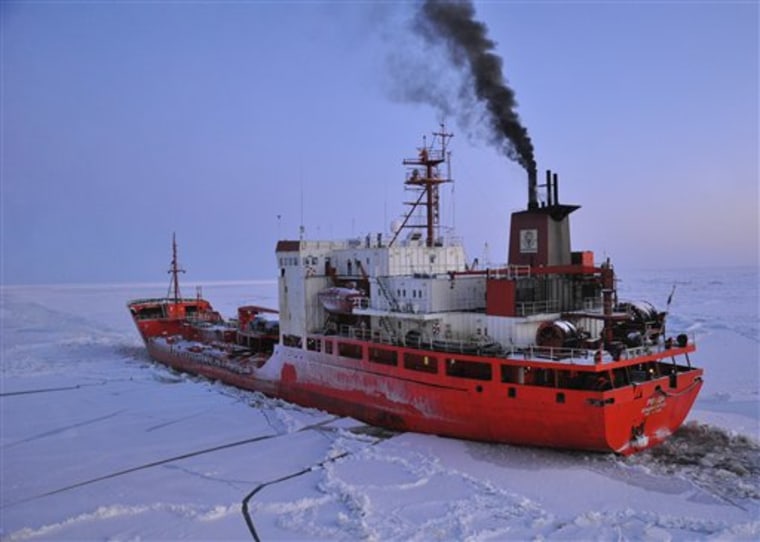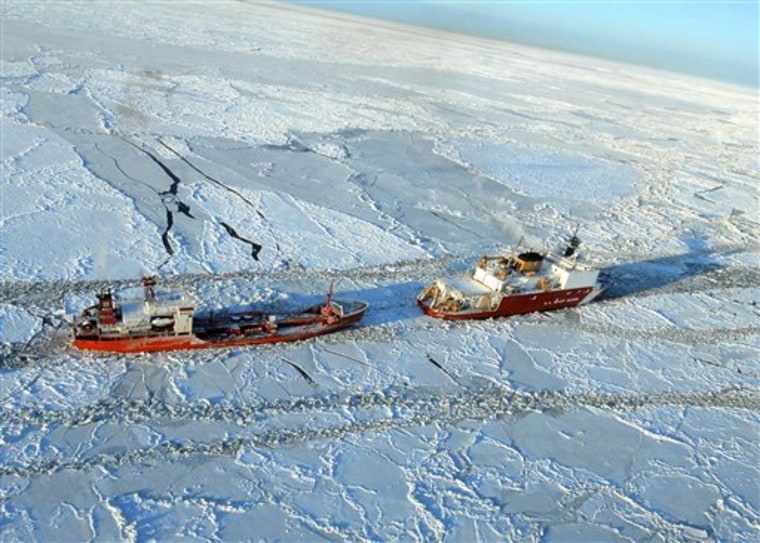A Coast Guard icebreaker is cutting a path through icy seas for a Russian tanker carrying much-needed fuel for the iced-in Alaska city of Nome.
The 370-foot tanker Renda, hauling more than 1.3 million gallons of fuel, is scheduled to arrive later Monday or Tuesday. It was less than 190 miles away on Saturday.
Video and still photo images released by the Coast Guard show the two vessels moving steadily through ice jammed seas.
The city of about 3,500 people on the western Alaska coastline did not get its last pre-winter fuel delivery because of a massive storm. If the delivery of diesel fuel and unleaded gasoline is not made, the city likely will run short of fuel supplies before another barge delivery can be made in spring.
Vitus Marine LLC spokesperson Stacey Smith told KTUU the Renda and the Coast Guard icebreaker Healy were stopped against an ice ridge just before dawn Saturday and waited until daylight before continuing their journey.
If the mission is successful, it will be the first time petroleum products have been delivered by sea to a Western Alaska community in winter.
The Coast Guard said the Russian tanker came upon ice about a foot thick very early Friday near Nunivak Island, a large island in the eastern Bering Sea. The tanker is following the Healy, the Coast Guard's only functioning icebreaker — a ship of special design with a reinforced hull made to move through ice.
The icebreaker should have no problem getting through the ice even if it becomes several feet thick, said Coast Guard Petty Officer First Class David Mosley.
"In the worst-case scenario, it might stop and back up and ram their way through the pressure ridges, where it gets really thick," he said.
However, he pointed out to the Alaska Dispatch that the scenario was nonetheless difficult. "The ice conditions are giving us a number of challenging issues," he said. "We can break it open but it is quickly closing."

The icebreaker is creating a path through the ice for the tanker.
Mosley told the Dispatch that the ships, crawling through the ice very close together, would struggle overnight as the darkness would make it difficult for the captains to keep watch and avoid knocking into each other.
"They are moving on at a crawl," Mosley said.
Supplying hospitals, schools
The Renda left Russia in mid-December after the barge delivery of 1.6 million gallons of fuel failed and Nome became iced-in for the winter.
The tanker is carrying more than 1 million gallons of diesel fuel loaded in South Korea and 300,000 gallons of unleaded gasoline picked up in Dutch Harbor in southwestern Alaska.
Sitnasuak Native Corp., the company that eventually signed a contract with Vitus Marine LLC to have a tanker delivery, considered flying supplies to Nome but decided against that plan because of the cost and the possibility fuel prices could jump to $9 a gallon. The tanker delivery is expected to be more costly than by barge but not as expensive as air delivery.
"I would be happy if we never ship through ice again," Sitnasuak Native Corp. chairman Jason Evans told the Dispatch.
The Native corporation is a major fuel supplier to the city, with between 800 and 1,000 customers including the hospital and schools.
The tanker is expected to arrive in Nome early Monday.
